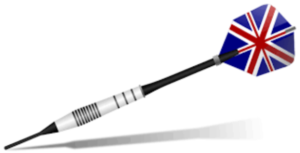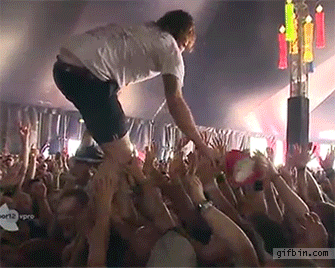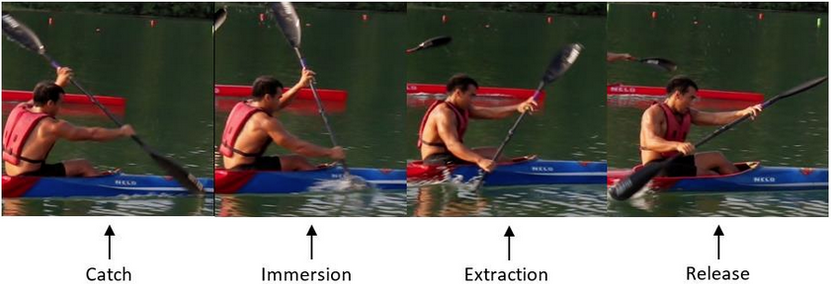Why does a packraft want to turn?
One of the first things people notice when they paddle a packraft is that it turns very easily. You dip your paddle in the water, pull back, and instead of scooting forward, the boat mainly just spins around. If you’re not prepared for this, you might find it really annoying and wonder if there’s something wrong with the boat’s design. Actually, this is normal packraft handling, and fortunately it’s easy to minimize this side to side motion with good paddling technique. I’ll give you some paddling tips below, but first the physics nerd in me is dying to get out, so here’s a bit about why packrafts have so little directional stability:
In general,
- Long, skinny boats (like sea kayaks, canoes, and ocean liners) have greater directional stability than short, tubby boats (like dinghies and river kayaks). This is because in order to spin a long boat you have to push a lot of water out of the way. You can demonstrate this phenomenon to yourself next time you’re wading in neck-deep water: with your arms pointing down beside your body (like a short boat), it’s easy to swivel your body from side to side, but if you hold your arms rigidly straight out from your body, side to side (like a long, skinny boat), it becomes a lot harder to swivel your body because you have to overcome the resistance of your arms pushing against a lot more water. It’s also because they have a greater “moment of inertia,” which basically means it takes more energy to rotate them because their mass is spread out farther from the center of rotation.
- Deep hulls and V-shaped hulls have better directional stability than flat bottomed boats, because a deep-hulled boat has a larger underwater profile, so more water must be pushed aside to turn it.
- Heavier boats have better directional stability than lightweight boats because
- they displace more water, so more water must be moved in order to turn them
- their greater mass gives them more inertia which must be overcome in order to turn them
- they are less affected by wind, for the reasons above
- Boats with keels have better directional stability than boats without keels because the keel acts as a large area of high length-to-width ratio underwater (similar to a long, skinny boat). The larger underwater profile means more water must be moved out of the way in order to rotate a boat with a keel.
- Boats with fins, rudders, or skegs near the stern have better directional stability than boats without those surfaces because they add area to the underwater profile of the boat behind its center of mass (similar to the fins at the rear of a dart). As the boat begins to turn, water hits the side of the fin, applying a force that pushes the rear of the boat back on track, similar to the way a weather-vane turns in the wind.
Looking at the factors above, it’s easy to see why a short, relatively wide, flat bottomed, ultralight packraft with no rudder, keel, or skeg will lack directional stability. But wait, it gets worse!
Because the paddler and gear make up about 97% of the total weight of a packraft on the water, weight distribution becomes an issue. Packrafts are designed to be as small as possible to make them light and portable, and given that the safest and most comfortable way to sit is on our butts with our legs pointing forward, that puts the bulk of our weight behind the packraft’s geometric center.
Why might that be a problem? Well, if you’ve every played a game of darts, you’ll know that each dart has a metal weight near its forward end and large, lightweight fins at the back. The weight is offset some distance from the fins by a shaft, and if you look at it from the side, you can see right away that the center of mass (a.k.a. “center of gravity”) is located far forward of the dart’s geometric center (the point where it would balance if you cut out its profile shape from a piece of paper).

This design gives darts so much directional stability that even if you throw them backwards they quickly flip around so the needle points in the direction of travel – it will oscillate back and forth a bit, but the stabilizing fins quickly dampen the oscillation and the dart flies smoothly through the air, point first. The same thing happens with a badminton shuttlecock, which has a weight on the front, and even a plastic cup partially filled with beer can be thrown and caught without spilling much beer because it has this same stable property of the center of gravity being far forward of the geometric center:

You can probably see where this is heading: with the packraft’s center of gravity being near or even behind its geometric center, as soon as you stop actively keeping it on course (i.e. paddling), the packraft starts to turn.
We can minimize this tendency by packing our gear towards the front of the packraft in order to move the center of gravity as far forward as possible, and by designing packrafts with longer and longer stern tubes, as the trend has been in recent years. Unfortunately this trend towards longer and longer packrafts comes at a cost in the form of greater weight and larger packed size, which you’ll notice on the trail. As with most things in life, it’s a trade-off.
So with all these things working against us, how are we supposed to paddle a packraft in a straight line? Well, it’s actually pretty easy, as you can see in the video below (you can also see how adding weight near the bow reduces the oscillation).
Tips for keeping your packraft on track:
- Pack your gear towards the front of the packraft. This moves the center of gravity as far forward as possible, minimizing the “dart thrown backwards” effect.
- When starting from a standstill, begin paddling with short, punchy strokes, quickly alternating from side to side, as at the beginning of the video above. This will minimize the yaw induced by each stroke.
- Once you reach cruising speed you can take normal paddle strokes and the bow will swing back and forth only a few degrees.
- A normal forward paddle stroke starts by catching the water as far forward as possible and it ends beside your hip – do not continue the stroke back past your hip!

- Pay attention to your heading. By varying the power of each paddle stroke, you can make small adjustments to your heading and avoid wasting energy making big S-turns when you’re trying to travel in a straight line.
Like riding a bicycle, these paddling techniques quickly become second-nature, and before long you won’t even notice you’re doing them, but it takes practice, especially if you’re not already an experienced kayaker.
Skegs (Fins)
You might be thinking that adding a fin or skeg to the packraft would be a logical way to improve its directional stability, and in theory it could work. I haven’t tried it myself because I like the way my packrafts handle, but I have seen at least a few people adding small skegs to their packrafts – I’m not sure how well it worked for them though. The problems with adding a solid skeg are a) it adds to the weight of the packraft, b) it could catch on something and rip a hole in your boat, and c) it might just flop around if you place it where it would be most effective, which is as far back as possible on the stern cone. If you attach it to the floor fabric ahead of the stern tube it will probably have no effect because that’s almost right under the center of gravity (it would be like moving the fins of a dart to the weighted end). If you do add a skeg to your packraft, please let us know how it works out.
13 Comments
Robín · September 21, 2023 at 9:35 am
Waiting for Grab Loops from Anfibio, Germany, to be pasted to fix the shrouds. I am interested in people trying to sail packrafts. Hope mine is successful.
https://twitter.com/RuttGih/status/1704895225804579243?t=7o8dVkSmLDC-uTOxYGjkgQ&s=19
Alex · October 4, 2023 at 2:38 am
Same hear and from my experience Vela Eola sailing kit works with packrafts and enables upwind sailing and adds a 4,8kg 50x20x15 package to the side holder of your backpack. After a year of trial & error here are the insights I wished I would have had earlier:
1. Leeboards/daggerboards held in place with at least a U-frame (e.g.: Eola) with very good strap-fixing are a must, otherwise as Matt mentioned, a light packraft is prone to drift sideways. Their right positioning is key (at least 20 % towards the bow from the center of the waterline. For my long MRS Nomad an extra long kayak fin/skeg (vs e.g.: Anfibio’s smaller fin) did the trick for surprisingly smooth upwind sailing, but finding the right balance too a while.
2. the strain on the shrouds (especially on the central “black” one fixed to the bow) is as expected enormous & the Eola rig works best if all of them are adjusted to the particular wind situation. So had to keep inflating the packraft on the water more often, since the usual loss of air volume the mast tends to “lean backwards” due to backwards pull sailing close reached/haul upwinds. On the long run an “A-frame” would really solve this problem
more to come, and here are first impressions in bad light conditions:https://www.youtube.com/watch?v=u4dnCIsGlOc
Matt (Admin) · October 4, 2023 at 11:22 am
Thanks for sharing your experience, Alex!
Sig · July 3, 2023 at 1:29 am
Anyone tried towing a long floating line from the centerline aft? This could help directional stability without the disadvantages of a fin.
I have no experience with packraft, but plenty experience from boating.
Patrick · July 10, 2021 at 12:44 am
Great info!
Alex · September 29, 2020 at 1:31 am
Thank you for this very helpful analysis! To your question: I have recently added 2 extra Anfibio fins/skegs to my Nomad S1 (total of 3) and one to a Biluta. In both cases it has increased speed and tracking significantly in deeper water. Easy to attach, hardly any weight and to great effect, especially when using a windpaddle for packraft-sailing. That having been said, both PR are as you mentioned of the longer, kayak-ish kind to be used in flatwater als well as in ww, so maybe the results would be different for more classically shaped packrafts. https://www.instagram.com/p/CEZi4vWFPJT/
Matt (Admin) · October 1, 2020 at 10:11 am
Interesting – thanks for the info!
Robín · August 31, 2023 at 1:35 am
Y just pasted (a few days ago) a Anfibio 85 grams skeg to a Itiwit 100 packraft, and as you wrote, i did not notice much improvement. I was disappointed and understand better now why.
I was thinking in the better way to install an efficient and light self tacking sail packraft system. Do you think an efficient sail system, for long distances on sea near the coast, is possible on a packraft ? Any good link ?
https://www.velaeola.com/2022/11/03/haikus-kit-eola-2/
Matt (Admin) · September 2, 2023 at 1:47 pm
True sailing (the ability to tack upwind) in a packraft is difficult because it requires some sort of keel/daggerboard/side board/centreboard to minimize sideways drift (plus a rudder for steering). If you just add a sail to a packraft you can sail downwind nicely, but not across the wind or upwind – if you try to turn into the wind you will just drift sideways. Even the kayak in the link you posted will probably not sail upwind. For upwind sailing, the center of pressure of the sail has to be at the center of pressure of the boat… this is difficult to explain without diagrams, but if you have ever tried to sail a dinghy with the centreboard removed then you will understand how hopeless it is. So in addition to a sail, you will need to design some sort of keel for the packraft. It would not be difficult, but I am not aware of anyone who has done it.
Robín · September 3, 2023 at 3:49 am
But, of course, the lack of rigidity of a packraft, its small weight inferior to the weight of the needed accessories, and the flat non hidrodynamic contact surface with the water will make it more difficult.
https://youtu.be/b6a3RJiUc3k?si=PHDHsQX6cGKLr9Y-
Matt (Admin) · September 3, 2023 at 8:48 am
I see in that second video the daggerboards. That kind of arrangement could work on a packraft, but as you say, the weight and bulk of the sailing rig are disproportionate to the packraft and a person would be better off with a dedicated sailing dinghy.
Uncle Fred · September 19, 2023 at 9:38 pm
I used the larger MSR skeg and found it helpful in reducing the torquing motion that you get while paddling. It also helps reduce rotational drifting when you stop paddling. However, I think asking a skeg to help with tack sailing is asking too much of a skeg alone. You’d need a more elaborate redesign as Matt describes. Consider just using a sail for downwind days, and paddling for anything else. You may find that upwind open-water paddling is quite difficult. I’ve done it on the Great Lakes this summer and found that you’ll need to be fairly strong. I don’t mind it, but I’m in my prime and frequent the gym daily. I would suggest you try open-water paddling against the wind before committing to a major trip.
Sebastiaan · July 27, 2021 at 3:10 am
Nice, thank Young. Any info about skegs (how to’s/instructions would be great). Do Young have a website of post somewhere ?